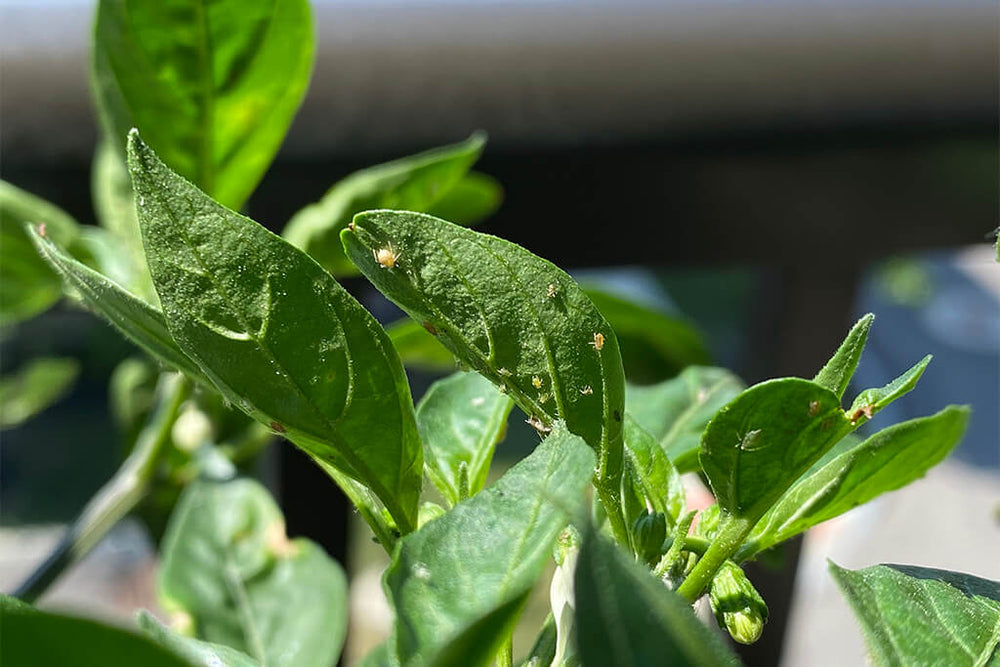
Aphids are tiny garden pests that can cause big damage. These little bugs will eat just about anything they land on—including vegetables, fruits, flowers, and even houseplants—and multiply rapidly. Finding aphids in your garden may feel overwhelming at first, but take a deep breath. There's plenty you can do to prevent and get rid of aphids. Here's everything you need to know about aphid control.
How to Get Rid of Aphids
What are aphids?
Aphids are tiny (1/8-inch long), pear-shaped insects that appear by the hundreds to feed on the tender new growth and flower buds of virtually all vegetables and many herbs. You may have aphids on roses, too. There are many species that vary in color—aphids can be green, pink, yellow, brown, gray, or black. Some have wings, but most do not.
What do aphids do?
Aphids suck plant juices, which causes wilting, stunted growth, and deformed leaves, stems, and fruit. Aphids typically gather along stems, buds, young fruit, tight places between leaves, and leaf undersides. They are worst in spring and fall and decline during hot weather. The honeydew trail their feeding leaves behind attracts ants and can turn into black mold. (PS: If you spot ants running up and down your plants, look closely for aphids.)
If you control aphids early, your plants can most likely recover. However, some species also transmit viruses to plants, especially in later-producing crops. These viruses can be more damaging to plants than the aphids themselves.
How do I prevent aphids?
As the saying goes, an ounce of prevention is worth a pound of cure, and that certainly holds true for aphids. The best way to prevent aphids is a combination of smart strategies that both repel and create barriers against them. Here are several proven ways to keep aphids at bay.
- Attract natural enemies. Ladybugs, lacewings, and hoverflies prey on aphids. If you have enough of these beneficial insects in your garden, they may take care of the aphids for you—or at least keep them to a level that doesn't significantly damage plants. Attract beneficial insects by growing a variety of flowers that blossom at different times during the growing season. Let parsley and cilantro that overwintered bloom in the garden in early spring to attract beneficial insects, too.
- Plant flowers that repel aphids. Intersperse your vegetables with companion plants that aphids don't like, such as nasturtiums, calendula, French marigolds, and sunflowers.
- Create a windbreak. Aphids are typically blown into gardens. Help block them by planting a "green screen" barrier on the windward side of your garden. Use tall plants, such as sunflowers, corn, cannas, and ornamental grasses.
- Understand their timing. Aphids tend to appear during early spring and fall. Anticipate their arrival by keeping an eye on susceptible plants. When you spot those first aphids, you can be ready to attack.
- Try a row cover. In some cases, you can cover plants with floating row covers, which allow sunlight, water, and air to pass while excluding insects. This is a tricky choice, though, because if just a few aphids are present when you add the blanket, you'll provide an ideal environment for those insects to multiply.
- Hang a birdhouse. Attract insect-eating birds, such as chickadees and house wrens, by hanging a house suited to their needs. These insect-eating birds devour many insects per day, including aphids, caterpillars, and other crop-eating pests.
How do I get rid of aphids?
It can be anxiety-inducing to find your beloved plants teeming with aphids. But don't panic! There are several ways you can take quick action against aphids. The main thing is to act fast, as aphids multiply rapidly.
Try water. You can sometimes remove aphids with a spray of water from the hose. Don't use too strong a blast though, or you might damage your plants.
Fortunately, aphids are easy to kill if you spray properly. Spray plants with an approved insecticide, such as Ortho® Insect, Mite & Disease 3-in-1 Ready to Use. Spray at dusk and be sure to follow label directions.
Watch for more. Aphids are weak flyers and tend to move about by wind. If you spot an outbreak on one plant, inspect other plants regularly to catch any new infestations in the early stages.
Need more info and local pesticide recommendations? Contact your regional Extension agent. You can find the nearest Extension office through the Cooperative Extension System map.
Aphids are never fun to discover, and their ability to reproduce quickly can make removal feel like a game of whack-a-mole. But don't despair! Through clever prevention strategies and by taking quick action when they do appear, you can minimize their impact on your precious plants.







 Herbs
Herbs
 Vegetables
Vegetables
 Fruit
Fruit
 Flowers
Flowers
 Succulents
Succulents


